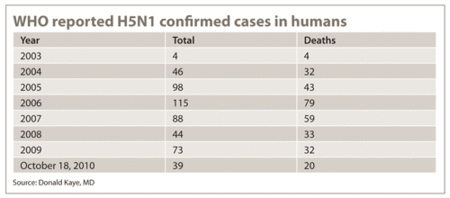H5N1: 800-lb gorilla or lightweight?
Click Here to Manage Email Alerts
The recent pandemic of H1N1 influenza has all but knocked avian influenza H5N1 out of the news and out of our thoughts. Now that the pandemic has officially ended, it is worth looking at a status report of H5N1 influenza.
The fear since its appearance has been the possibility of mutation of H5N1 or recombination with a human strain to produce an infectious agent that would be capable of causing an influenza pandemic. That coupled with the high mortality rate of H5N1 in infected humans has been a major concern. Although different clades of virus have evolved, none have proved to have potential for a pandemic.
OIE and WHO
According to data from the World Organization for Animal Health (OIE) and WHO, since its appearance in Hong Kong in 1997 in poultry and humans, H5N1 virus has caused about 6,800 outbreaks in domestic fowl holdings in 52 countries. These reports of H5N1 in domestic fowl have been from 30 countries in Asia, 12 countries in Europe and 10 countries in Africa. Human cases have occurred in only 15 of these countries. In addition, H5N1 has been reported only in wild birds in 10 countries.

Human cases have been continuously reported since 2003. As shown in the Table, the number of WHO confirmed cases in humans reported each year (deaths/cases) has been: 2003 (4/4); 2004 (32/46), 2005 (43/98), 2006 (79/115), 2007 (59/88), 2008 (33/44), 2009 (32/73) and for 2010, as of Oct. 18 (20/39). As of Oct. 18, the world wide count is 507 confirmed cases with 302 deaths (60%). The number of reported confirmed cases undoubtedly represents an underestimation, but it at least gives a year-to-year comparison.
Countries involved
The countries involved with the number of cases are: Azerbaijan (8); Bangladesh (1); Cambodia (10); China (39); Djibouti (1); Egypt (112); Indonesia (170); Iraq (3); Lao People’s Democratic Republic (2); Myanmar (1); Nigeria (1); Pakistan (3); Thailand (25); Turkey (12); and Vietnam (119). Cases have been reported most of the years of the epidemic from Cambodia, China, Egypt, Indonesia and Vietnam, with only sporadic cases from the other countries. Most cases have occurred from November to April.
Most human cases were restricted to the Far East in the early years of the epidemic. Lately, most cases are being reported from Indonesia and Egypt (with 53 and 69 cases, respectively, in 2008 through Sept. 1, 2010).
There has been a major discrepancy between the mortality rate in Egypt and the rest of the world. The mortality rate in Egypt stands at 36/112 (32%) compared with 266/395 (67%) for the rest of the world (P<.0001). Although the clade of virus that has been circulating in Egypt is different from the clades found in Asia, there is no good evidence for differences in virulence. Rather, the lower mortality in Egypt has been attributed by some to more rapid treatment with oseltamivir in Egypt, but again, there is little solid evidence for this. Others have attributed it to age differences among the infected individuals in Egypt compared with elsewhere.
Mild or asymptomatic infection is uncommon as serosurveys of contacts with poultry or patients have revealed few positives.
Infected poultry
The overwhelming majority of cases with documented exposure acquired the H5N1 virus from sick or dead domestic poultry or much less frequently wild birds. There have been more than 40 clusters of H5N1 in humans. In the great majority, the source was common exposure to infected poultry. However, limited human-to-human transmission seems to have occurred in some of these clusters. Clusters have most often involved blood relatives (eg, mother and son and not husband and wife). This has suggested that genetic susceptibility plays a role.
As shown in the Table, the epidemiological curve of world cases peaked in 2006 and has subsequently stabilized.
To put the number of cases and deaths in perspective when talking about an epidemic of severe viral non-influenza respiratory disease, it is worth comparing the numbers in the figure with the experience with severe acute respiratory syndrome (SARS). With SARS, between November 2002 and July 2003 (less than a year), there were many more cases (8,096 known infected cases) and deaths (774 confirmed deaths) than with H5N1 during 6-plus years.

Course of epidemic
It is impossible to predict what the subsequent course of the current epidemic will be. However, we have now had more than 5 years of geographic spread of the virus with huge numbers of birds (poultry and wild water birds) infected. There have been countless exposures of humans to the virus but the numbers remain small. In its present form, the virus would not constitute a menace in an industrialized country. Most disease has occurred in the young who take care of backyard flocks and have close exposure, rather than in professional workers who work on poultry farms. The median age of patients with H5N1 influenza infection has been approximately 18 years, with 90% of patients 40 years of age or younger and older adults underrepresented. An outbreak in poultry would be quickly recognized and controlled on a poultry farm, and there would be minimal opportunities for spread from poultry to people.
The major fear has been that either mutation of the virus or recombination with human strains would occur to make H5N1 more infectious to and communicable among humans. However, there must have been many opportunities for mutation of the virus or recombination with circulating strains of human strains (eg, pandemic H1N1 virus) to occur, and yet, there has not been emergence of an H5N1 strain better adapted to humans. As each year passes, such an occurrence seems less and less likely.
Disclosure: Dr. Kaye has no direct financial interest in any of the products mentioned in this article nor is he a paid consultant for any companies mentioned.
